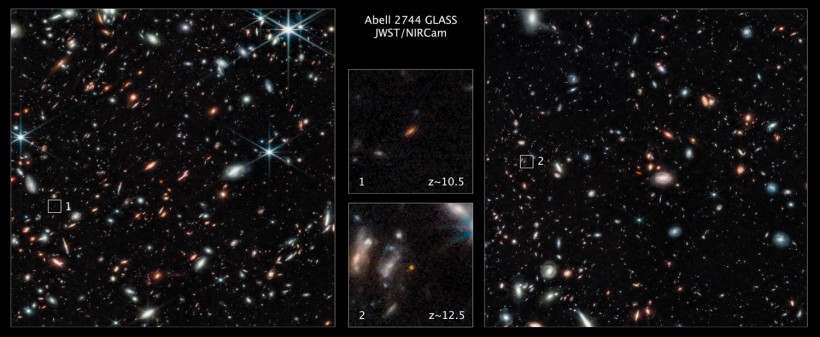NASA's James Webb Space Telescope (JWST) snapped an image showing an 'undiscovered country of galaxies' that formed just 350 million years after the Big Bang, which happened 13.8 billion years ago.
MailOnline reported that the 350-million-year-old galaxy, which was discovered alongside a galaxy that appeared 450 million years after the Big Bang, is exceptionally bright and is considered to be the farthest starlight ever seen by human eyes.

Two of the farthest galaxies seen to date are captured in these Webb Space Telescope pictures of the outer regions of the giant galaxy cluster Abell 2744. The galaxies are not inside the cluster, but many billions of light-years farther behind it. The galaxy labeled (1) existed only 450 million years after the big bang. The galaxy labeled (2) existed 350 million years after the big bang. Both are seen really close in time to the big bang which occurred 13.8 billion years ago. These galaxies are tiny compared to our Milky Way, being just a few percent of its size, even the unexpectedly elongated galaxy labeled (1).
A Whole New Chapter in Astronomy
The National Institute for Astrophysics in Rome, Italy who led the team said that the discovery is like an undiscovered country of early galaxies that is only now seen.
Paola Santini, a co-author of the study, said in a statement that observations like this can make a head explode as it opens a whole new chapter in astronomy. He even compared it to an archaeological find that suddenly discovered a lost city or something that existed for too long but is only now found.
The galaxies were more mature than the Milky Way but observations reveal that they are smaller. But perhaps due to being very massive with lots of low-mass stars, they are much brighter than later galaxies that formed in the universe.
More so, Garth Illingworth of the University of California at Santa Cruz suggested that later galaxies could be less massive because they consist of fewer extraordinary bright stars known as Population III stars.
It is just a theory; but if this is true, the stars in the system would be the first stars ever born with blazing temperatures and made up of primordial hydrogen and helium before stars could even generate heavier elements in their nuclear fusion. No human can prove this as no one has ever seen such scorching, primordial stars in the universe.
That is why this discovery is incredibly fascinating. These galaxies would have started coming together some 100 million years after the Big Bang, cutting short the dark ages of the universe.
JWST Doing Its Work
Per the press release via Webb Space Telescope, present distant estimates for the two galaxies are based on measuring their infrared colors. Follow-up spectroscopy measurements reveal how light has been stretched in the expanding universe will help in verifying cosmic measurements.
Study co-author Pascal Oesch from the University of Geneva in Switzerland said that the extreme brightness of these galaxies is truly puzzling as it challenges the current understanding of galaxy formation. But like discovering previous ones, JWST's Infrared Camera (NIRCam) has made it possible to find new ones.
NIRCam is a first-of-its-kind that enables the space telescope to detect cosmic objects that its predecessors and other telescopes have missed. Lockheed Martin space science and instrumentation director Alison Nordt noted that the technology is a key for observing the first galaxies that formed after the Big Bang and achieved all science objectives of the telescope.
RELATED ARTICLE: NASA James Webb Space Telescope's 'First Deep Field' Image Is Now Accessible at a Fashionable Dress
Check out more news and information on James Webb Space Telescope in Science Times.










!['Cosmic Glitch' in Einstein's Theory of General Relativity Could Be Explained in This New Scientific Tweak [Study]](https://1721181113.rsc.cdn77.org/data/thumbs/full/53435/258/146/50/40/cosmic-glitch-in-einsteins-theory-of-general-relativity-could-be-explained-in-this-new-scientific-tweak-study.jpeg)



